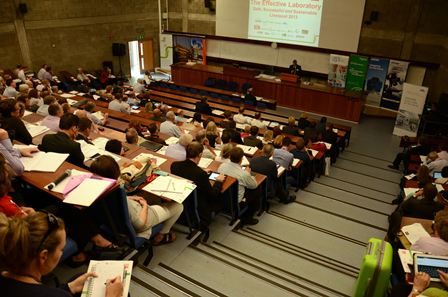The University’s Central Teaching Hub (CTL) has hosted The Effective Laboratory: Safe, Successful and Sustainable (S-Lab) Conference 2013, giving the institution the opportunity to showcase the award-winning facility to academics, technicians, and professionals from the estates, engineering and design sector.
More than 300 people attended event, which highlights best practice in laboratory design and operation.
Organised by S-lab an sponsored by HOK, the conference emphasised the synergies between safety, organisational success, and sustainability.
Distinguished speakers
It attracted a host of distinguished speakers including; Professor Jim Smith, Director of the MRC National Institute for Medical Research; Dr Martino Picardo, CEO, Stevenage Bioscience Cataylst; Paul Janssenwillen, Research and Development Lead at Pfizer; Professor Sir Ian Diamond, Vice-Chancellor, University of Aberdeen and Chair, Universities UK Modernisation Task Force; and Professor Donald Levy, Vice-President for Research and National Laboratories, University of Chicago.
Pro-Vice-Chancellor for Science and Engineering, Professor Stephen Holloway and Professor Paul Nolan from Physics delivered a joint keynote address on ‘The CTL and Lab Strategy at the University of Liverpool.’
Bringing together different science subjects
Discussing the impact that the new facility has had on the University, Professor Holloway, said “The project has fostered a major cultural change in the way that experimental science is delivered to our undergraduates. By bringing together many different science subjects under a single roof along with expert teaching and technical support, the University leads the nation in how it is possible to deliver world-class laboratory training. Using new, industry-standard equipment, the students are also ‘work ready’ should they wish to carry on with a career in the sciences. Finally, curricula are beginning to emerge that cut across subject boundaries which is vitally important as it will be our undergraduates that help to solve tomorrows ‘big’ problems, such as climate change or energy technology, and these are not challenges that fit conveniently into a single subject area.
Academic lead for the project, Professor Nolan added: “The CTL has driven curriculum reorganisation and helped us to generate a sustainable strategy for STEM subjects. At the same time, we have improved efficiency across disciplines, improved space utilisation, and delivered significant cost savings.”
The CTL was the winner of the S-Lab 2012 New Building award, and the Guardian Higher Education Award for University Facility, demonstrating excellence, creativity and innovation in its concept and delivery.
It cost £23 million to build and contains £5.6 million of teaching equipment.
